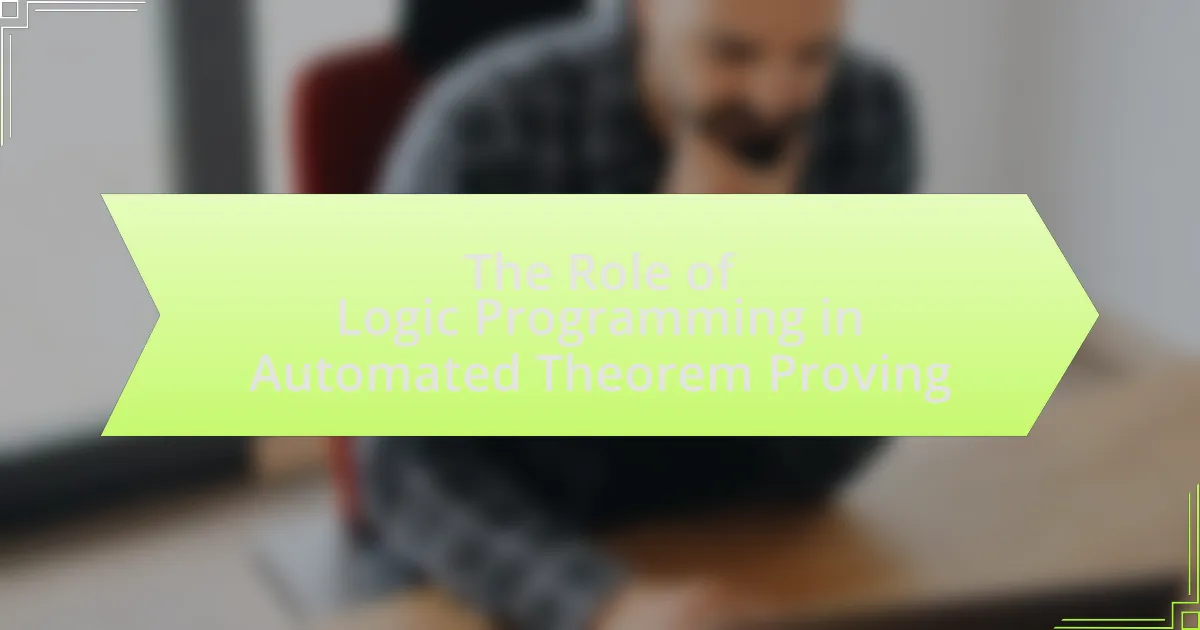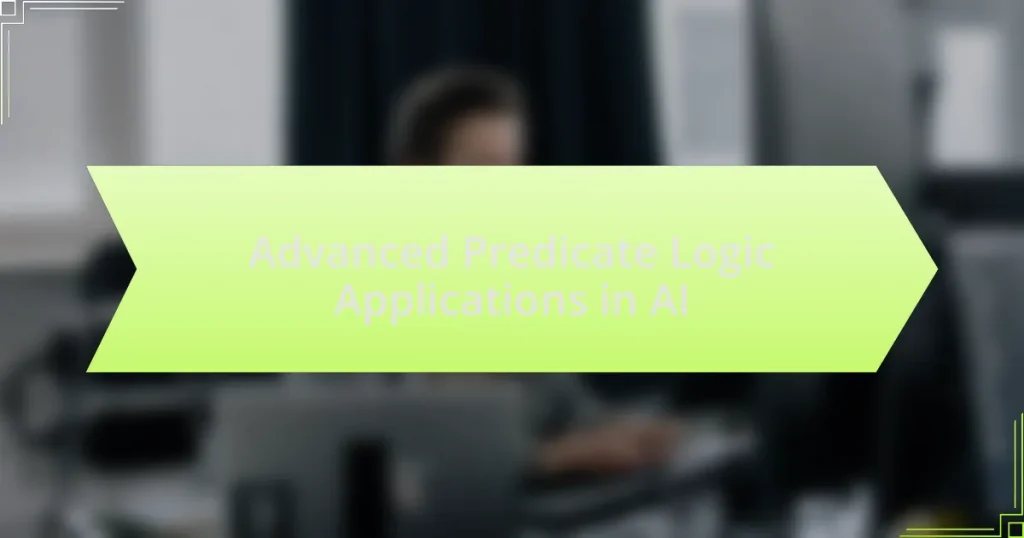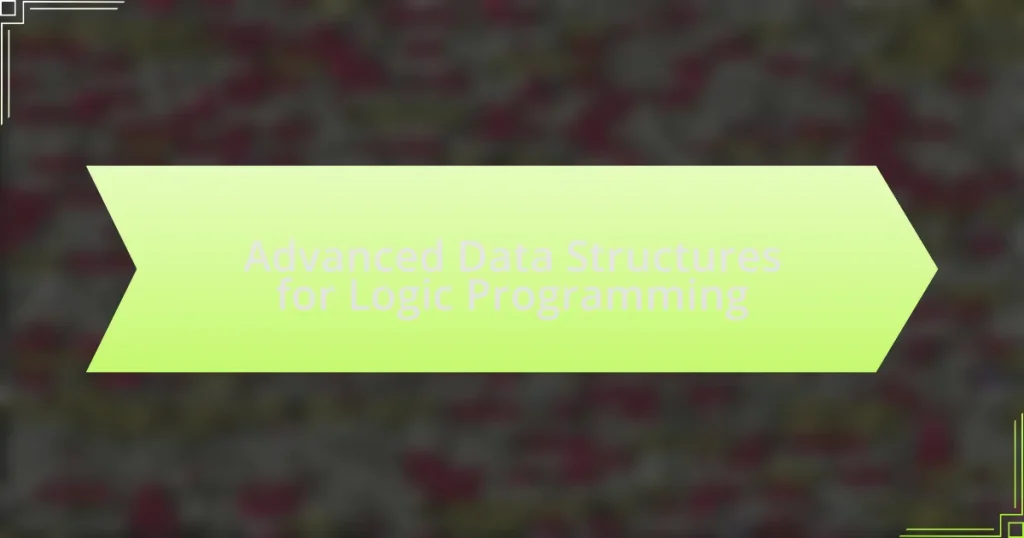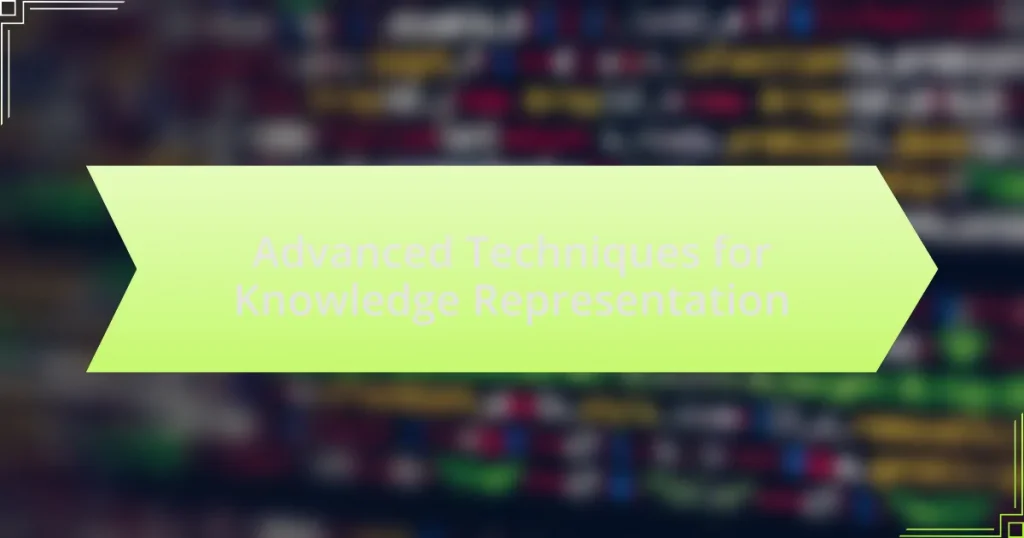Logic programming is a formal framework that plays a vital role in automated theorem proving by enabling the representation and manipulation of logical statements. This article explores how logic programming contributes to theorem proving through its declarative approach, highlighting key components such as resolution, unification, and Horn clauses. It discusses the advantages of logic programming, including efficiency in proof search and expressiveness in representing complex relationships. Additionally, the article addresses challenges faced in this domain, such as efficiency and scalability, while providing best practices for optimizing the use of logic programming in automated theorem proving tasks.
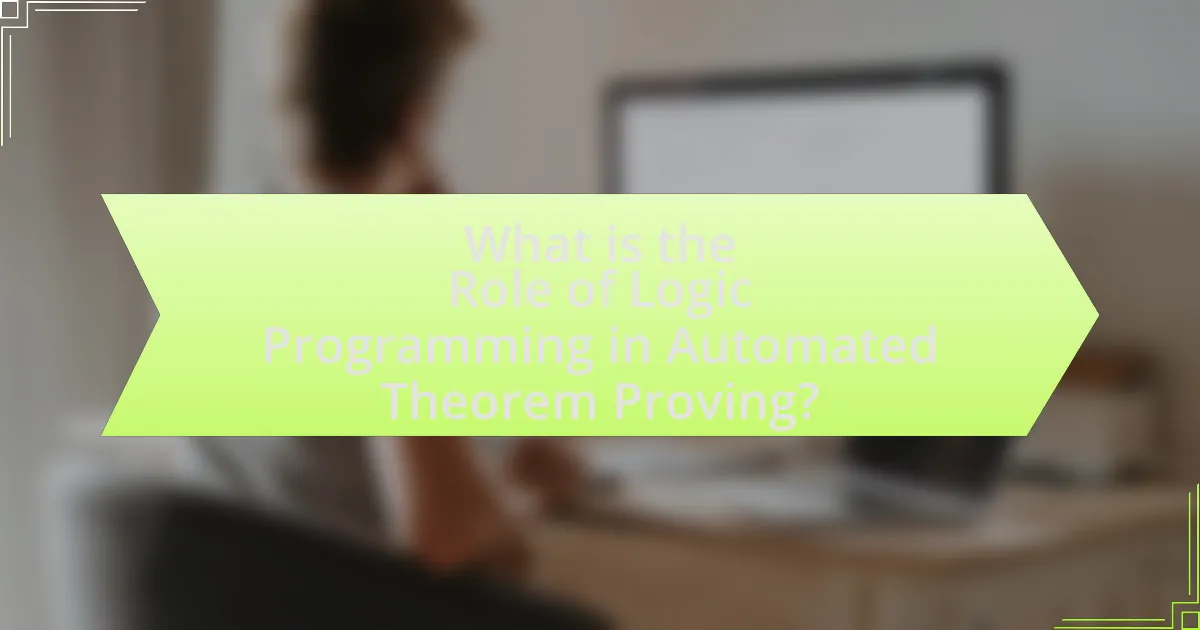
What is the Role of Logic Programming in Automated Theorem Proving?
Logic programming plays a crucial role in automated theorem proving by providing a formal framework for representing and manipulating logical statements. This framework allows for the systematic derivation of conclusions from premises using rules of inference, which is essential for proving the validity of mathematical theorems. Logic programming languages, such as Prolog, utilize a declarative approach that enables the expression of complex logical relationships and facilitates automated reasoning processes. The effectiveness of logic programming in this domain is evidenced by its application in various automated theorem provers, which have successfully solved numerous challenging problems in mathematics and computer science, demonstrating the power of logic-based reasoning in achieving automated proofs.
How does Logic Programming contribute to Automated Theorem Proving?
Logic programming significantly contributes to automated theorem proving by providing a formal framework for representing logical statements and rules. This framework allows for the systematic derivation of conclusions from premises using inference rules, which is essential in theorem proving. For instance, Prolog, a prominent logic programming language, utilizes a resolution-based approach that enables automated reasoning by searching through possible proofs efficiently. The effectiveness of logic programming in this domain is evidenced by its application in various automated theorem provers, such as E and Vampire, which leverage logic programming techniques to handle complex logical problems and verify mathematical theorems.
What are the fundamental principles of Logic Programming?
The fundamental principles of Logic Programming include the use of formal logic as a programming paradigm, where programs are expressed in terms of relations and rules rather than procedures. Logic Programming is based on the concepts of facts, rules, and queries, allowing for declarative problem-solving. The primary proof of its validity lies in its foundation on first-order predicate logic, which enables automated reasoning and theorem proving, as demonstrated in systems like Prolog. These systems utilize a resolution-based inference mechanism to derive conclusions from given facts and rules, showcasing the effectiveness of Logic Programming in automated theorem proving.
How does Logic Programming differ from other programming paradigms in theorem proving?
Logic programming differs from other programming paradigms in theorem proving by emphasizing a declarative approach, where the focus is on expressing facts and rules rather than detailing control flow. In logic programming, such as Prolog, theorems are proven through a process of logical inference, allowing the system to derive conclusions from given premises. This contrasts with imperative programming paradigms, which require explicit instructions for computation and often rely on algorithms that dictate the sequence of operations. The declarative nature of logic programming facilitates automated reasoning, enabling systems to explore multiple paths of inference simultaneously, which is less efficient in traditional paradigms that follow a linear execution model.
Why is Logic Programming important in the context of Automated Theorem Proving?
Logic programming is important in the context of automated theorem proving because it provides a formal framework for representing and manipulating logical statements. This framework allows for the systematic derivation of conclusions from premises using inference rules, which is essential for proving the validity of logical expressions. Logic programming languages, such as Prolog, enable the implementation of algorithms that can automatically search for proofs by exploring possible logical deductions. The significance of this approach is underscored by its application in various domains, including artificial intelligence and formal verification, where automated reasoning is crucial for ensuring correctness and consistency in complex systems.
What advantages does Logic Programming offer for theorem proving tasks?
Logic Programming offers several advantages for theorem proving tasks, primarily through its declarative nature and formal semantics. This programming paradigm allows for the expression of logical statements and relationships in a way that is both human-readable and machine-processable, facilitating the automation of reasoning processes.
The use of unification and backtracking in Logic Programming enables efficient search strategies for finding proofs, as it systematically explores possible solutions while maintaining a clear logical structure. Additionally, the ability to represent complex relationships and rules succinctly enhances the expressiveness of theorems being proved.
Furthermore, established systems like Prolog have been widely used in various applications, demonstrating the effectiveness of Logic Programming in practical theorem proving scenarios. These systems leverage built-in inference mechanisms that can handle a variety of logical constructs, making them powerful tools for automated reasoning.
How does Logic Programming enhance the efficiency of theorem proving?
Logic programming enhances the efficiency of theorem proving by providing a formal framework that allows for automated reasoning through logical inference. This framework utilizes rules and facts to derive conclusions systematically, which streamlines the process of proving theorems. For instance, Prolog, a prominent logic programming language, employs a resolution-based approach that efficiently searches through possible proofs by leveraging backtracking and unification techniques. These methods reduce the search space and improve the speed of finding valid proofs, as evidenced by their application in various automated theorem proving systems, which have demonstrated significant performance improvements in solving complex logical problems compared to traditional methods.
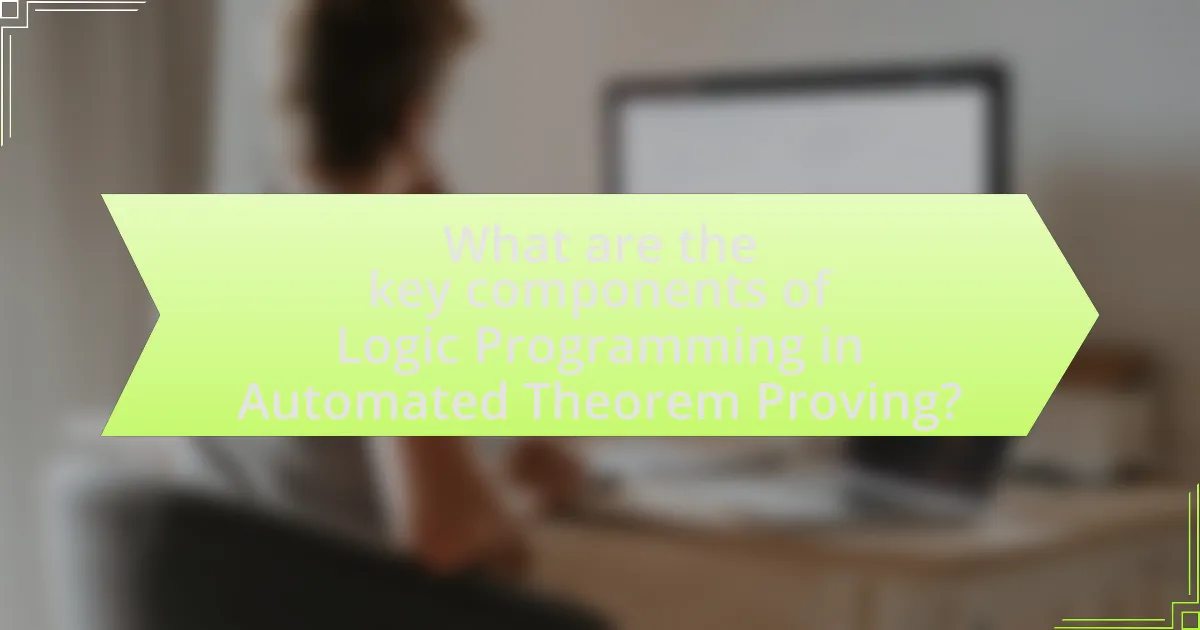
What are the key components of Logic Programming in Automated Theorem Proving?
The key components of Logic Programming in Automated Theorem Proving include a formal syntax, a formal semantics, inference rules, and a resolution mechanism. Formal syntax defines the structure of logical statements, while formal semantics provides meaning to these statements. Inference rules are the logical principles that guide the derivation of conclusions from premises, and the resolution mechanism is a method for proving the validity of logical statements by refuting their negations. These components work together to facilitate automated reasoning and theorem proving, enabling systems to derive conclusions from a set of axioms and rules effectively.
What are the main techniques used in Logic Programming for theorem proving?
The main techniques used in Logic Programming for theorem proving include resolution, unification, and backward chaining. Resolution is a rule of inference that allows for deriving a contradiction from a set of clauses, effectively proving theorems by refutation. Unification is the process of making different logical expressions identical by finding a substitution for their variables, which is essential for applying resolution. Backward chaining is a goal-driven approach that starts with the theorem to be proved and works backward to find supporting facts or axioms, making it efficient for many logic programming applications. These techniques are foundational in automated theorem proving, as they enable systematic reasoning and deduction within logical frameworks.
How do resolution and unification play a role in Logic Programming?
Resolution and unification are fundamental mechanisms in logic programming that facilitate automated theorem proving. Resolution is a rule of inference that allows for the derivation of new clauses from existing ones by eliminating a common literal, thereby simplifying logical expressions. Unification, on the other hand, is the process of making different logical expressions identical by finding a substitution for their variables. Together, these mechanisms enable logic programming systems to systematically explore and prove the validity of logical statements. For instance, in Prolog, a popular logic programming language, resolution is used to derive conclusions from a set of facts and rules, while unification is employed to match queries with these facts and rules, ensuring that the correct substitutions are applied to reach a solution. This interplay between resolution and unification is crucial for the efficiency and effectiveness of automated theorem proving in logic programming.
What is the significance of Horn clauses in theorem proving?
Horn clauses are significant in theorem proving because they facilitate efficient resolution and proof search in logic programming. Their structure, which consists of a disjunction of literals with at most one positive literal, allows for a streamlined application of the resolution principle, making it easier to derive conclusions from a set of premises. This efficiency is evidenced by the fact that many automated theorem provers, such as Prolog, rely on Horn clauses to perform logical inference, enabling them to handle large sets of rules and facts effectively. The use of Horn clauses thus enhances the performance and scalability of theorem proving systems.
What tools and frameworks utilize Logic Programming for Automated Theorem Proving?
Tools and frameworks that utilize Logic Programming for Automated Theorem Proving include Prolog, Coq, and Isabelle. Prolog is a widely used logic programming language that supports theorem proving through its inference engine. Coq is an interactive theorem prover that allows for the formal verification of mathematical theorems using a functional programming approach combined with logic. Isabelle is another popular proof assistant that employs a higher-order logic framework for theorem proving. These tools are validated by their extensive use in both academic research and practical applications in formal verification and automated reasoning.
Which popular logic programming languages are used in theorem proving?
Prolog and Coq are popular logic programming languages used in theorem proving. Prolog is widely recognized for its use in artificial intelligence and computational linguistics, while Coq is known for its formal verification capabilities and interactive theorem proving. Both languages facilitate the representation of logical statements and the execution of inference rules, making them effective tools in the domain of automated theorem proving.
How do these tools implement Logic Programming concepts?
These tools implement Logic Programming concepts by utilizing formal rules and logical inference to derive conclusions from a set of premises. For instance, Prolog, a prominent logic programming language, employs a resolution-based approach where facts and rules are defined, allowing the system to query and infer new information through backtracking search. This method aligns with the principles of first-order logic, enabling automated reasoning and theorem proving. Additionally, tools like Coq and Isabelle leverage type theory and constructive logic, providing a framework for formal verification and proof development, thus reinforcing the foundational aspects of Logic Programming in automated theorem proving.
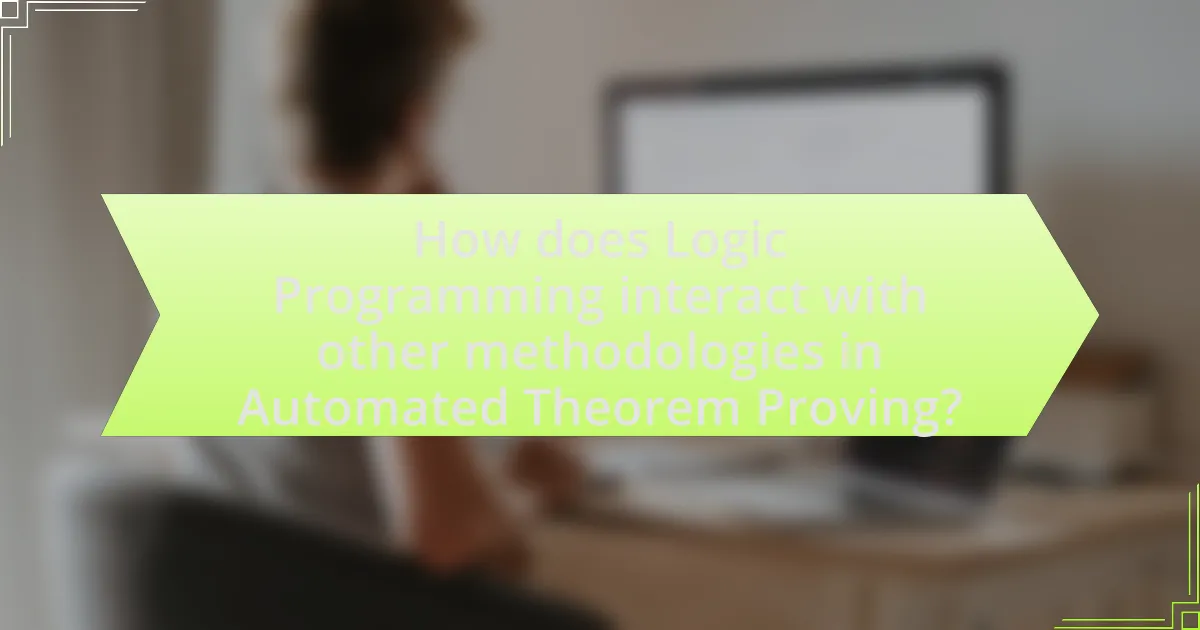
How does Logic Programming interact with other methodologies in Automated Theorem Proving?
Logic programming interacts with other methodologies in automated theorem proving by providing a formal framework that facilitates reasoning and problem-solving through logical inference. It integrates seamlessly with methodologies such as resolution-based theorem proving, model checking, and constraint satisfaction, enhancing their capabilities. For instance, logic programming languages like Prolog utilize backtracking and unification, which complement resolution techniques in automated theorem proving, allowing for more efficient search strategies. Additionally, the declarative nature of logic programming allows for the expression of complex problems in a more intuitive way, which can be beneficial when combined with other methodologies that require formal specifications. This interaction has been validated through various implementations and research, demonstrating improved performance in theorem proving tasks when logic programming is employed alongside other methodologies.
What are the relationships between Logic Programming and other proof techniques?
Logic programming is closely related to other proof techniques, particularly in its use of formal logic to derive conclusions from premises. It shares foundational principles with resolution-based proof systems, where both rely on logical inference rules to establish the validity of statements. Additionally, logic programming integrates with model checking, as both approaches utilize logical formulas to verify system properties. The relationship is further evidenced by the use of Prolog, a logic programming language, which employs backtracking and unification, techniques also found in automated theorem proving. These connections highlight how logic programming serves as a bridge between various proof methodologies, enhancing their applicability in automated reasoning tasks.
How does Logic Programming integrate with model checking?
Logic programming integrates with model checking by providing a formal framework for specifying and verifying properties of systems. In this context, logic programming languages, such as Prolog, enable the representation of system behaviors and properties as logical formulas. Model checking tools then utilize these representations to systematically explore the state space of a system, verifying whether the specified properties hold. This integration is supported by the ability of logic programming to express complex relationships and constraints, which model checkers can analyze through automated reasoning techniques. For instance, the use of temporal logic in model checking allows for the verification of properties over time, which can be directly encoded in logic programming constructs, facilitating a seamless interaction between the two methodologies.
What role does Logic Programming play in hybrid theorem proving approaches?
Logic Programming serves as a foundational component in hybrid theorem proving approaches by providing a formal framework for representing knowledge and reasoning. This framework allows for the integration of different reasoning techniques, such as deduction and model checking, enhancing the overall efficiency and effectiveness of theorem proving systems. For instance, Prolog, a prominent logic programming language, enables the encoding of logical statements and rules, facilitating automated reasoning processes. The combination of logic programming with other methodologies, such as constraint satisfaction or decision procedures, has been shown to improve the performance of theorem provers in various applications, including formal verification and artificial intelligence.
What challenges does Logic Programming face in Automated Theorem Proving?
Logic Programming faces several challenges in Automated Theorem Proving, primarily including issues of efficiency, expressiveness, and scalability. Efficiency is a significant concern, as many logic programming systems struggle with the computational complexity of theorem proving, leading to slow performance on large or complex problems. Expressiveness poses another challenge; while logic programming can represent a wide range of problems, certain logical constructs may not be easily expressible, limiting the applicability of automated theorem proving techniques. Scalability is also critical, as the ability to handle increasingly large datasets and complex logical structures is essential for practical applications, yet many existing systems falter under such demands. These challenges hinder the effectiveness and adoption of Logic Programming in the field of Automated Theorem Proving.
What limitations exist within Logic Programming for theorem proving?
Logic Programming has several limitations for theorem proving, primarily including expressiveness, efficiency, and undecidability. The expressiveness limitation arises because certain logical constructs cannot be easily represented in logic programming languages, which can restrict the types of problems that can be effectively solved. Efficiency issues stem from the computational complexity of theorem proving algorithms, which can lead to significant performance bottlenecks, especially for large or complex theories. Additionally, undecidability is a fundamental limitation, as some logical statements cannot be proven or disproven within a given logical system, making it impossible to guarantee a solution for all cases. These limitations highlight the challenges faced in utilizing Logic Programming for effective theorem proving.
How can these challenges be addressed or mitigated?
Challenges in automated theorem proving can be addressed by enhancing the efficiency of logic programming techniques. Implementing advanced algorithms, such as those based on resolution and unification, can significantly reduce computational complexity. For instance, the use of heuristics in search strategies has been shown to improve the performance of theorem provers, as evidenced by the success of systems like Prover9, which utilizes such methods to solve complex problems effectively. Additionally, integrating machine learning approaches can optimize proof search processes, allowing systems to learn from previous proofs and adapt strategies accordingly. This combination of improved algorithms and machine learning techniques provides a robust framework for mitigating the challenges faced in automated theorem proving.
What best practices should be followed when using Logic Programming in Automated Theorem Proving?
Best practices in using Logic Programming for Automated Theorem Proving include ensuring clarity in the formulation of logical statements, utilizing efficient search strategies, and maintaining modularity in code design. Clarity in logical statements enhances the accuracy of theorem proving, as ambiguous or poorly defined statements can lead to incorrect conclusions. Efficient search strategies, such as depth-first or breadth-first search, optimize the theorem proving process by reducing computational overhead. Modularity in code design allows for easier debugging and maintenance, facilitating the integration of new logic rules or algorithms. These practices are supported by the success of established theorem provers like Prover9 and E, which emphasize structured and efficient logic programming approaches.
How can practitioners optimize their use of Logic Programming for effective theorem proving?
Practitioners can optimize their use of Logic Programming for effective theorem proving by employing strategies such as modular design, efficient search algorithms, and leveraging existing libraries. Modular design allows for the separation of concerns, making it easier to manage complex proofs and reuse components. Efficient search algorithms, such as depth-first or breadth-first search, enhance the speed of theorem proving by systematically exploring possible solutions. Additionally, utilizing established libraries, like Prolog or Coq, provides access to optimized functions and proven techniques, which can significantly reduce development time and improve accuracy. These strategies collectively enhance the effectiveness of Logic Programming in theorem proving by streamlining processes and improving performance.
What common pitfalls should be avoided in Logic Programming applications?
Common pitfalls to avoid in Logic Programming applications include improper handling of recursion, failure to manage variable scope, and neglecting to optimize performance. Improper recursion can lead to infinite loops or excessive resource consumption, which hampers application efficiency. Variable scope issues may result in unintended variable bindings, causing incorrect results or logic errors. Additionally, neglecting performance optimization can lead to slow execution times, especially in complex theorem proving tasks, where efficiency is crucial for practical applications. These pitfalls can significantly undermine the effectiveness of Logic Programming in automated theorem proving.
